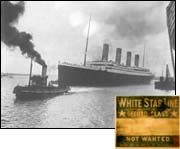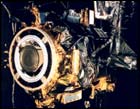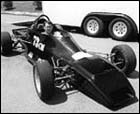
Parylene Application Hall of Fame
As a Leader in Parylene Technology, over the years SCS has had an honor to work on some of the most cutting edge, fascinating, or simply historically significant projects in technology. This is a collection of just a few of the projects we are especially proud to support.
RMS Titanic
 On April 12, 1912 The RMS Titanic hit an
Iceberg as it made its maiden transatlantic voyage. The wreckage of the
Titanic sat undisturbed for close to 80 years in the harsh chilled
salt-water environment 5000 ft below the surface of the North Atlantic.
On April 12, 1912 The RMS Titanic hit an
Iceberg as it made its maiden transatlantic voyage. The wreckage of the
Titanic sat undisturbed for close to 80 years in the harsh chilled
salt-water environment 5000 ft below the surface of the North Atlantic.
Recovery efforts ran into a difficult problem when recovering paper products such as magazines, luggage tags, and boarding passes, from the wreckage site. Paper products recovered from the wreckage were left too delicate to take the transition from the waterlogged state to the natural dried state.
SCS was called in to find a method to use Parylene to stabilize these items so that generations would be able to see these items first hand. Today these items can be touched, picked up, and shared by many. These items would have been otherwise lost to ocean if not for SCS.
Mars Global Observer
Any object launched into space undergoes a tremendous
amount of stress during launch and even during space travel. The force of
acceleration shocks the delicate electronics. The rapid change in
temperature and pressure can cause condensation to develop. And the
vibration and movement of the space vehicle can cause dust and other
contaminants to become dislodged and may interfere with the operation of
the electronics.
 |
For this purpose, most electronics in space are protected with some type of coating. Because it is difficult to impossible to repair any electronics once they are in space, space engineers prefer to use the best available options from the start and avoid potential problems in the future. In addition, cure forces, gasses trapped in the coating, and the mass of coating are other unique issues scientists and engineers need to consider in space system designs.
This is what the people from SCS had to consider when they were asked to coat the six instrument assemblies including the Mars Orbital Camera on the Mars Global Observer Satellite.
The Mars Global Observer was a satellite launched in 1996 to map the surface of the Martian terrain. The mission was highly successful and gave us the best view to date, of topography of another planets surface.
International Space Station
Neptec Design Group, Ltd. of Kanata, Ontario, Canada, is
building the Space Vision System (SVS) that will be used in the
construction of the International Space Station by NASA and the space
agencies of 12 other countries.
The components of the Space Station will be carried into orbit by a series of shuttle missions, and assembled over six year period.
The SVS uses special electronics, software and graphic displays to give improved vision and thereby enhance control of the huge shuttle robot arm. The system functions by tracking visual targets on items being handled, using cameras on both the shuttle and the space station.
This tracking will give operators a precise, moving graphic image of load position in three dimensions, and allow for more accurate control than could be achieved using earlier robot arm controls. Before the SVS concept was developed, astronauts had to rely on images from video cameras, and on limited views through small spacecraft windows to guide them in controlling robot functions. The new vision system will be used on each shuttle mission as the station is assembled, allowing astronauts to precisely control the spacecraft's robotic arm for docking, moving cargo, and assembling components.
 The Canadian electronics company is
supplying NASA with vision systems for both ground training of astronauts
at the Johnson Space Flight Center in Houston, Texas, and for use with the
International Space Station.
The Canadian electronics company is
supplying NASA with vision systems for both ground training of astronauts
at the Johnson Space Flight Center in Houston, Texas, and for use with the
International Space Station.
Construction of the International Space Station is scheduled to begin with a December, 1998 flight, with completion anticipated by the year 2004 after 100 separate shuttle missions and assembly phases. The station will afford scientists and engineers a platform for complex industrial and medical experiments in the unique environment of space, and will serve as a permanent orbiting science institute in space.
Deep Space Propulsion Test
Parylene was recently used in a particularly exciting
aerospace project with Southwest Research - coating objects for Deep Space
1. This 770 lb. spacecraft was launched in July of 1998 to demonstrate a
variety of new technologies that will support ambitious future orbital and
deep space missions.
 |
This NASA project includes an ion engine for propulsion in the vacuum of deep space. It operates by expelling positively charged atoms generated from an inert gas, and uses solar energy to create the reaction. The engine's collimator, a device that aligns and controls ion flow, was coated with Parylene to protect its surface before launch, during the rigors of departure from the earth's atmosphere, and throughout the life of the mission. While an ion engine creates only about 90 millinewtons (20 thousandths of a pound) of thrust, this force creates slow but constant acceleration in the vacuum of deep space, builds to very high speed over a period of months, and operates far more efficiently than conventional chemical propulsion. Less than 12-inches long, and requiring a fuel supply of only 145 lbs., an ion engine can be carried aloft by a relatively small, inexpensive launch vehicle.
The Deep Space 1 ion engine was fired on September 18, 1999, and will thrust almost continuously over the next three months as the NASA probe approaches two comets for study. Deep Space 1 is managed by NASA's Jet Propulsion Laboratory in Pasadena, California, for the NASA Office of Space Science, Washington, DC.
Holocaust Era Bibles
In late 1994, an unassuming package arrived at the SCS Coating
Facility in Clear Lake Wisconsin. This package contained six small,
battered books, included a prayer book and the first five books of the
Biblical Old Testament known to Jewish people as the Torah.
The history of these careworn volumes sets them apart, for they survived the Nazi Holocaust. It seems that these volumes were saved through the efforts of a Swiss physician living in Germany, a Dr. Rupp who was instrumental in rescuing a number or Polish and German Jews during World War II.
The books were given to Dr. Rupp in Berlin by a Dr. Rosenblat; after Dr. Rosenblat's escape from the Warsaw ghetto. They had been entrusted to him, in turn, by a captive who requested that they be saved, treated with reverence, and passed to a synagogue or other Jewish Institution.
It was too dangerous to take religious books out of Germany at the time, so Dr. Rupp buried them before fleeing the city near the end of the war. When the war ended, he returned to Berlin and dug up the books.
The years and the historic events had taken their toll on the books. SCS was contacted to preserve the books by Yoram Curiel (An acquaintance of Dr. Rupp's son). SCS devised a way to coat and preserve these books, and stop the further disintegration. These books have since been donated to a Jewish institution.
Parylene Race Car
 Parylene has proven itself in another
unusual and unexpected application - stopping oil pan and valve cover oil
leaks on an SCCA C Modified Class racing engine. According to SCS CAD
designer Rick Swarts, his Ford 1600cc 4-cylinder power plant was plagued
with oil leakage, and since the valves on this small race car engine
require frequent manual adjustment, he had to replace the cork valve cover
gasket nearly every time the valve cover was removed.
Parylene has proven itself in another
unusual and unexpected application - stopping oil pan and valve cover oil
leaks on an SCCA C Modified Class racing engine. According to SCS CAD
designer Rick Swarts, his Ford 1600cc 4-cylinder power plant was plagued
with oil leakage, and since the valves on this small race car engine
require frequent manual adjustment, he had to replace the cork valve cover
gasket nearly every time the valve cover was removed.
At the suggestion of one of his co-workers, Rick decided to try coating the gaskets with Parylene N to see if performance could be improved. He was pleased to find that oil loss was reduced to zero, and the valve cover gasket tolerates repeated removal and replacement without tearing. Swarts explains that engine thermal cycling appears to be a major issue in gasket life. The coefficients of thermal expansion for the three critical components - valve cover (or oil pan), gasket and engine block - differ substantially from one another. While the gaskets change very little in size between hot and cold conditions compared to the block and head, and since they tend to adhere to both surfaces, they are mechanically stressed with every heat-up and cool-down cycle. This eventually fractures the cork and allows oil to escape.
The racing engine has undergone at least 30 thermal cycles since the Parylene-coated gaskets were installed, and the valve cover has been removed and reinstalled a dozen times. Yet both engine gaskets continue to perform with no damage and no oil loss.
IRS Evidence Recovery
As one of the unique ways SCS is helping our criminal justice
system, SCS has been involved in various projects with the Internal
Revenue Service on tax fraud cases.
It seems that in some cases of tax fraud, important evidence and/or tax records are burned beyond recognition. Parylene is used to reinforce the burned records so that they can be examined and used for evidence.
In one particular example, the IRS forensic experts were having problems reviewing charred evidence critical in a particular tax fraud case. The writing on the paper was still distinguishable, however the ash segments were curled and extremely brittle.
A light Parylene coating reinforced the ashes so that they could be reassembled (like a puzzle) into a single document. The individual pieces were put between glass, examined, and submitted as critical evidence in the relevant court case.
J.J. the Whale
A dehydrated and malnourished young gray whale, affectionately
nicknamed J.J. and found washed up on a California beach in the Winter of
1996, was nursed to health by SeaWorld in San Diego over a period of about
14 months.
SCS became involved in this unusual project through Brent Stewart, Ph.D. senior research biologist for Hubbs-SeaWorld Research Institute. Stewart played a key role in the design and assembly of tracking instrumentation attached to the young whale before its release back into the sea on March 31, 1998 to join other migrating gray whales on their long trip to summer waters along the Alaskan coast.
Dr. Stewart explains that transmitters attached to J.J.'s blubbery dorsal fin were designed to monitor her activity for approximately 18 months. The transmitters are fastened through the whale's tough skin with several subdermal toggle anchors or mini harpoons. The biologist wanted to ensure that the anchors would be completely biocompatible, with no chance of rejection or ill effects to the young whale's body over time. Dr. Stewart arranged for stainless-steel attachment hardware to be Parylene coated.
The transmitter sends data bursts approximately every 40 seconds to two polar satellites when the whale breaks the surface, forwarding data to the SeaWorld institute including latitude, longitude and a record of depth as the young whale dives and surfaces. Cable fastened to the toggle anchors are designed to corrode and separate after about 18 months - the anticipated life of its batteries. At that time the transmitter will fall away and sink to the bottom of the ocean.
JSTARS Surveillance System
Parylene conformal coating makes an important contribution to
the performance of the U.S. military's recently-developed Joint Tactical
Information Distribution System - known as JSTARS. This airborne radar
system, used effectively during the Gulf War and by peacekeeping forces in
Bosnia, provides high resolution images of moving ground targets. It gives
commanders timely and accurate information on mobile enemy forces
operating within a very large area.
According to Jon Harris, the JSTARS Program Manager for Electromagnetic Sciences, Inc., Norcross, Georgia, a critical JSTARS circuit board and microwave antenna assembly is Parylene coated to protect it from the harsh airborne environment. This microwave phase shifter subassembly is mounted on the exterior of JSTARS surveillance aircraft, where it is exposed to mechanical shock as well as wide variations in temperature and humidity.
Electromagnetic Sciences (ELMG) manufactures key components of the JSTARS system. Harris explains that the company is a long-time user of Parylene. "This is virtually the only coating that can do the job for the JSTARS microwave phase shifter. It provides moisture resistance, pinhole-free coverage, and dielectric protection - without adding significant mass or thermal forces. Parylene ideally suits our protective coating requirements," he said.
The unique protective properties of Parylene are achieved in a thin film layer, adding very little weight to the complex radar subassembly. JSTARS microwave phase shifter assembly.
Copyright and Disclaimerc © Xuan Bao Hao Corp. 隱私保護及安全聲明 | 智慧財產權 請使用IE 4.0以上版本之瀏覽器